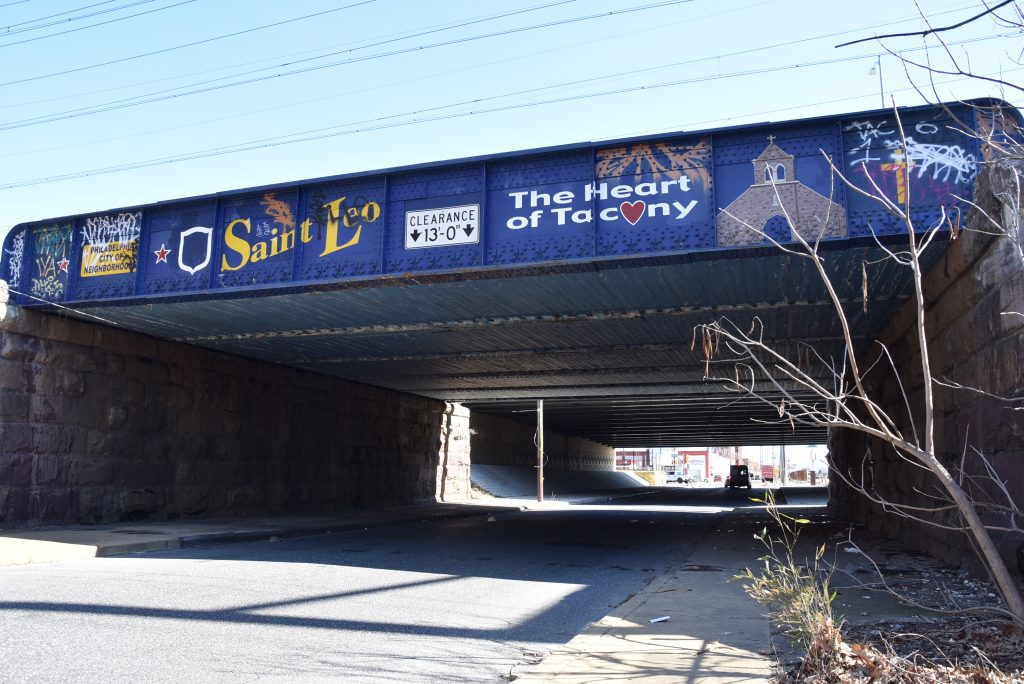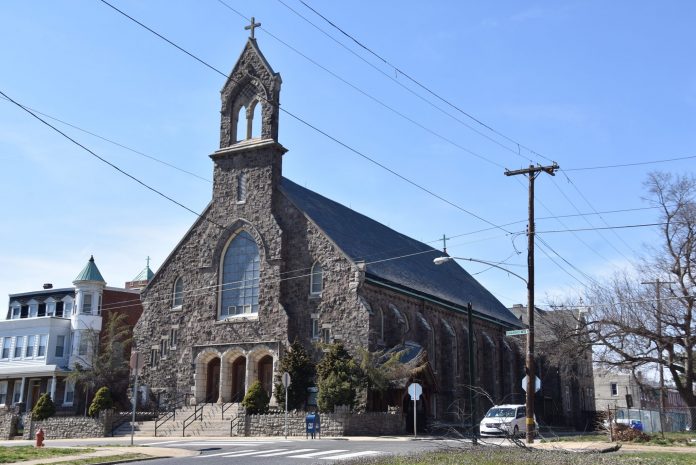It was permanently closed in January and is no longer considered a Catholic church by the
Archdiocese of Philadelphia. JACK TOMCZUK / TIMES PHOTO
An Unruh Avenue railroad overpass refers to nearby St. Leo the Great Church as “the heart of Tacony.”
For nearly 120 years, the church was the site of weddings, baptisms, confirmations and many other gatherings. St. Leo became a worship site in 2013 after being merged with Our Lady of Consolation Parish, and it permanently closed in January.
Now, the Tacony Community Development Corporation, with the support of the neighborhood’s historical society, is pushing to have the St. Leo church building placed on the Philadelphia Register of Historic Sites.
However, it’s not clear whether the Archdiocese of Philadelphia or OLC is on board with the proposal, which would prevent the property from being demolished or significantly altered without permission from the city’s Historical Commission.
Another wrinkle: St. Leo is set to be sold. An agreement is pending with a denomination associated with the Seventh Day Adventists, according to Archdiocese spokesman Ken Gavin.
“The agreement of sale is currently on hold given the request for historic designation,” Gavin said in an email. “That could represent a serious financial hardship for the parish community.”
He said the Archdiocese and OLC have not yet taken a position on St. Leo’s historic nomination.
“The Archdiocese and its parishes are deeply concerned with number of historic nominations of its churches throughout the City and the effect designation has on the financial resources of the individual parishes,” Gavin said.
Tacony CDC Executive Director Alex Balloon said the organization is in the process of nominating several properties for the historic register and identified St. Leo as an important building in the history of the area.
The CDC hired historian Celeste Morello to draw up the application, which was submitted to the Historical Commission earlier this month.
In 2016, the CDC and other organizations worked together to get a portion of Tacony designated by the federal government as a National Historic District.
“St. Leo’s was identified as a character-defining building and a contributing structure to that district,” Balloon said.
“Whether the building’s being sold or not isn’t really the concern,” he added. “The concern is that it’s protected in the future.”
Balloon said the CDC also has pending historic nominations for the Tacony Post Office and Tacony Club, both on the 4600 block of Longshore Avenue. Other properties will be nominated in the near future, he said.
The Historical Society of Tacony sent a letter of support along with the CDC’s application, according to president Lou Iatarola.
“(St. Leo) helps tell the story of the neighborhood in addition to the fact that it’s just a very impressive structure, both inside and outside,” Iatarola said. “I think of all the churches, certainly it’s one of the most–if not the most–prominent in the neighborhood.”

church as “the heart of Tacony.” JACK TOMCZUK / TIMES PHOTO
St. Leo, a stone structure that sits on the corner of Unruh and Keystone Street, was opened in 1894 by Archbishop Patrick John Ryan, though the cornerstone was blessed 10 years prior.
It was established when Tacony was a “company town,” with most of its residents working for Disston Saw Works, which was once one of the country’s largest employers, according to the Historical Commission application.
The church was built to accommodate the neighborhood’s growing Irish population but welcomed all Catholics, the document says.
Catholics in the area made sacrifices and raised money for St. Leo’s construction, according to Morello, who has worked to nominate other churches to the historic register.
“They did everything really high class,” she said.
St. Leo was crafted by architect Frank R. Watson, of Frankford, who was known for designing churches. He also designed St. Mark’s Church in Frankford and many other buildings.
Perhaps the most striking aspect of the church is the open bell tower, which can be seen clearly by drivers on I-95.
In 1920, stained glass windows made by D’Ascenzo Studios were installed at St. Leo, according to the application. Iatarola said the windows contain the names of some of the neighborhood’s famous founding families, including the Disstons and the Gatzmers — the latter set up the Philadelphia and Trenton Railroad in the 19th century.
Some in the Tacony community expressed concern earlier this month that OLC had hired contractors to remove the stained glass windows from the church.
OLC referred all questions to the Archdiocese. Gavin said the process of removing the stained glass was stopped due to the pending historic designation.
The Seventh Day Adventists do not want the windows in the church, according to Gavin.
The stained glass, if removed, would go to the Archdiocesan Ecclesiastical Exchange, where they would be available for purchase by priests, religious or other authorized buyers for use in an appropriate setting, Gavin said.
St. Leo will be considered by a Historical Commission committee on April 17, Morello said. If the application moves forward, it will then be considered by the full commission for final approval in May, she said.
Morello believes St. Leo has a good chance of making it onto the register, but she expects a fight from the Archdiocese.
“Across the board, they oppose,” said Morello, who is also working on having St. Dominic Church in Holmesburg placed on the register. “They come up with different reasons all the time.”
Gavin noted that the Archdiocese owns 100 buildings in the city that are over 100 years old and said about a quarter of active parishes are already on the historic register.
Archbishop Charles J. Chaput approved the deconsecration of St. Leo after a request from OLC’s pastor, the Rev. Joseph Farrell, made in consultation with parish leaders, according to Gavin. He said Farrell decided to sell the church after getting approval from the OLC pastoral and finance councils.
When the announcement was made that St. Leo would close in December, the Archdiocese said that maintaining the church was putting a significant financial strain on OLC. ••






